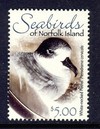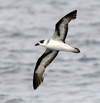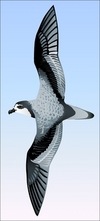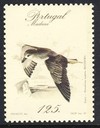Genus Pterodroma

Phoenix Petrel - The Phoenix Petrel, Pterodroma alba is a medium-sized, up to 35cm long, tropical seabird with a wingspan of 83cm. It has a dark brown upperparts plumage, white below and whitish throat. Both sexes are similar.
Trindade petrel - The petrel has 2 color morphs, a dark phase and a light phase, with intergrades between the two also occurring. There are also 2 separate populations, one occurring in the south Pacific, sometimes seen in Hawaii; the other occurring in the south Atlantic, nesting off Brazil, with rare sightings in the Gulf Stream off the southeastern United States. The little-known Pacific subspecies Pterodroma heraldica may be a distinct species . It uses oceanic islands, atolls, nesting on cliff ledges, ridges or rocky slopes. On some islands, nesting birds are threatened by feral cats and rats.
Henderson petrel - During Captain Cook's voyages in the eighteenth century, Daniel Solander wrote in his manuscript of the procuring of a petrel which he named Procellaria atrata. It was not until 1912, when Gregory Mathews published Solander's account, and created this name . However, Mathews did not actually designate a new type, as what Solander had described was considered to be merely hypothetical.
Chatham Island Petrel - Chatham Petrels nest in burrows under the forest canopy to which they are generally faithful to over time. Leaves are used as nesting material. Each pair lays a single white egg in December-January and the chicks fledge in May-June.
Barau's Petrel - The name commemorates Armand Barau, an agricultural engineer and ornithologist from the French territory of Réunion in the Indian Ocean. It is one of the most recently discovered species of seabird and was only described in 1964, although it was known to local people prior to that.
Collared Petrel - Its breeding range is uncertain and it is currently known to breed only in Fiji where it occurs on Gau and possibly other islands. It formerly bred in the Cook Islands and may still breed in Vanuatu and the Solomon Islands. It is an unconfirmed breeder in Samoa, American Samoa and French Polynesia.
Bermuda petrel - Commonly known in Bermuda as the Cahow, a name derived from its eerie cries, this nocturnal ground-nesting seabird is the national bird of Bermuda, and a symbol of hope for nature conservation. It was thought extinct for 330 years. Its dramatic rediscovery as a "Lazarus species", that is, a species found to be alive after being considered extinct for centuries, has inspired documentary filmmakers.
Jamaican Petrel - This species was last collected in 1879, and was searched for without success between 1996 and 2000. However, it cannot yet be classified as extinct because nocturnal petrels are notoriously difficult to record, and it may conceivably occur on Dominica and Guadeloupe.
White-necked Petrel - This species resembles the Falla's Petrel, P. occulta, but is slightly larger at 43 centimetres in length, 30–32 centimetres in wing span and 380–545 grams in weight. It has a black cap, white rear neck, dark grey back, wings and tail, and a darker rump. The underparts are white with dark bases to the primary feathers. The upperparts of worn birds become darker.
Cook's Petrel - This species is highly pelagic, rarely approaching land, except to nest and rear young. It ranges in the Pacific Ocean from New Zealand north to the Aleutian Islands. It sometimes can be seen well off the west coast of the United States and well off the west coast of tropical South America. Cook's Petrel feeds on mostly fish and squid, with some crustaceans taken. This bird breeds on offshore islands near New Zealand.
Defilippe's Petrel - Its natural habitats are open seas and rocky shores.
White-necked Petrel - The Juan Fernández petrel is endemic to one island in Chile, Isla Alejandro Selkirk. The breeding population was estimated at 1,000,000 pairs in 1985-86, and there may be up to 3-5 million birds globally. It is threatened by predation from introduced species and, to a lesser extent, habitat loss from introduced herbivores . The World Conservation Union assessed this species as Vulnerable due to its endemic status and threats from introduced predators, and it is on BirdLife's Red-list.
Gon-gon - Fea's Petrel is a small seabird in the gadfly petrel genus, Pterodroma. It was previously considered to be a subspecies of the Soft-plumaged Petrel, P. mollis, but they are actually not closely related at all. However, P. feae is very closely related to Zino's Petrel and Deserta's Petrel, two other species recently split from P. mollis.
Black-capped Petrel - This long-winged petrel has a grey-brown back and wings, with a white nape and rump. Underparts are mainly white apart from a black cap and some dark underwing makings. It picks food items such as squid from the ocean surface.
Pterodroma heraldica - The petrel has 2 color morphs, a dark phase and a light phase, with intergrades between the two also occurring. There are also 2 separate populations, one occurring in the south Pacific, sometimes seen in Hawaii; the other occurring in the south Atlantic, nesting off Brazil, with rare sightings in the Gulf Stream off the southeastern United States. The little-known Pacific subspecies Pterodroma heraldica may be a distinct species . It uses oceanic islands, atolls, nesting on cliff ledges, ridges or rocky slopes. On some islands, nesting birds are threatened by feral cats and rats.
Bonin Petrel - The Bonin Petrel is a small gadfly petrel, 30 cm long with a wingspan of around 67 cm. It has a white head with a black cap and face markings; overall the head often has a scaled appearance. Its pale grey upperparts have darker primaries and wing coverts creating a M mark across the back. The underwing is white with dark edging and a patch at the carpal joint and across underwing coverts. The tail is dark grey, and the rest of the plumage is white, except for a dark half collar on the breast. Like the rest of the Pterodroma petrels the black bill is short and hooked. The legs and feet are pink with dark patches.
Schlegel's Petrel - The species feeds mostly on squid, which comprises 87% of its diet in some studies; it will also feed on lanternfishes as they ascend to the surface at night, as well as on crustaceans.
Scaled petrel - This species is highly pelagic, rarely approaching land, except to nest and rear young. The Mottled Petrel feeds on mostly fish and squid, with some crustaceans taken. It is a transequatorial migrant, breeding in New Zealand and some of the lesser islands, then moving to the Bering Sea, concentrating in the Gulf of Alaska and the Aleutian Islands.
White-headed Petrel - White-headed Petrels breed alone or in colonies in burrows dug among tussocks and herbfields on subantarctic islands. They appear to feed pelagically on cephalopods and crustaceans .
White-winged Petrel - The subspecies P. l. leucoptera breeds on Cabbage Tree Island in New South Wales, Australia while P. l. caledonicus breeds in New Caledonia and possibly in Vanuatu and on Raivavae in French Polynesia. The Collared Petrel is sometimes regarded as a third subspecies but is often split as a separate species.
Stejneger's Petrel - This species is highly pelagic, rarely approaching land, except to nest and rear young. It occurs in the Pacific Ocean, nesting in the Juan Fernandez Islands off Chile. It is a transequatorial migrant, finding its way to subtropical waters off Japan before returning to its nesting sites. It has been reported well off the west coast of the United States.
Great-winged Petrel - There are two recognized subspecies of P. macroptera - P. m. macroptera and P. m. gouldi, the latter of which is endemic to New Zealand, and is often called the Grey-faced Petrel.
Freira - Zino's Petrel , or Freira, is a small seabird in the gadfly petrel genus. It has also been called the "Madeira Petrel", but this name invites confusion with the Madeira Storm Petrel and is best avoided. Zino's Petrel was previously considered to be a subspecies of Soft-plumaged Petrel P. mollis, but they are not closely related. However, P. madeira is very closely related to Fea's Petrel, another species recently split from P. mollis.
Chatham Island Taiko - The first specimen of the Magenta Petrel was collected from His Italian Majesty's ship Magenta on July 22, 1867 in the South Pacific ocean, midway between New Zealand and South America. The link between it and the presumed-extinct Chatham Island Taiko was only confirmed when the first Taiko was caught on Chatham Island, New Zealand by David Crockett on January 1, 1978. Formerly widespread on Chatham Island, the Taiko is now confined to the forested Tuku valley system on the south-west of the island.
Soft-plumaged Petrel - It breeds on islands in the Southern Hemisphere, nesting on Tristan da Cunha, Gough Island, the Prince Edward Islands, Crozet Islands and on the Antipodes Islands of New Zealand. It disperses outside the breeding season, reaching eastern South America north to Brazil, southern Africa and Australia. It has occurred as a vagrant in Israel and Jordan.
Kermadec Petrel - It is found in Australia, Chile, Japan, Mexico, Micronesia, New Zealand, Norfolk Island, Pitcairn, and the United States.
Black-winged Petrel - It is found in Australia, French Polynesia, Japan, New Caledonia, New Zealand, Norfolk Island, and the United States.
Galapagos Dark-Rumped Petrel - The Galapagos Petrel is an endemic marine bird that nests in areas of high humidity in the highlands of five islands of the Galapagos Archipelago . In the past, the petrel population was severely affected by introduced mammals. These introduced animals depredated and altered the nesting colonies, placing the petrel in the category of Critically Endangered species listed in the Red Book of Threatened Birds. One of the greatest threats to the population of petrels is the presence of the Black Rat , an introduced species that is the principal cause of mortality of eggs and hatchlings of the species. Introduced plants have also altered and restricted the nesting habitat. The reproductive period of the petrels covers about eight months of the year. A study carried out in 2002 showed an egg-laying period between March to the end of October, with a peak occurring during the first two weeks of August.
Pycroft's Petrel - The Pycroft's Petrel is a species of seabird in the Procellariidae family. It is found in Japan, New Zealand, Norfolk Island, the United States, United States Minor Outlying Islands, and Wallis and Futuna Islands. It breeds only in New Zealand, nesting only on Stephenson, Poor Knights Islands, Hen and Chickens Islands, and Mercury Islands. Its natural habitats are temperate forests, temperate shrubland, and open seas.
Hawaiian Petrel - The petrel was formerly found on all the main Hawaiian Islands except Niʻihau, but today it is mostly restricted to Haleakalā crater on Maui; smaller populations exist on Mauna Loa on the island of Hawaiʻi, Waimea Canyon on the island of Kauaʻi, Lānaʻihale on Lānaʻi, and possibly Molokaʻi.
Solander's Petrel - Of roughly pigeon like proportions , the bird was once also numerous on Norfolk Island . However, its population here was consumed by starving epicurean transportees, sent to Norfolk Island as way of punishment. Nonetheless it numbers some 100,000 on Lord Howe. Graceful and supple in flight, the Providence Petrel has a cumbersome propensity on the ground, making it vulnerable from attack by predators.
Murphy's Petrel - Very little is known about this species of Petrel. It occurs in the South Pacific, nesting on rocky islets and cliffs off tropical oceanic islands in the Austral, Tuamotu, and Pitcairn island groups. The bird has been recorded off the coast of the Hawaiian Islands and well off the Pacific Coast of the United States.














